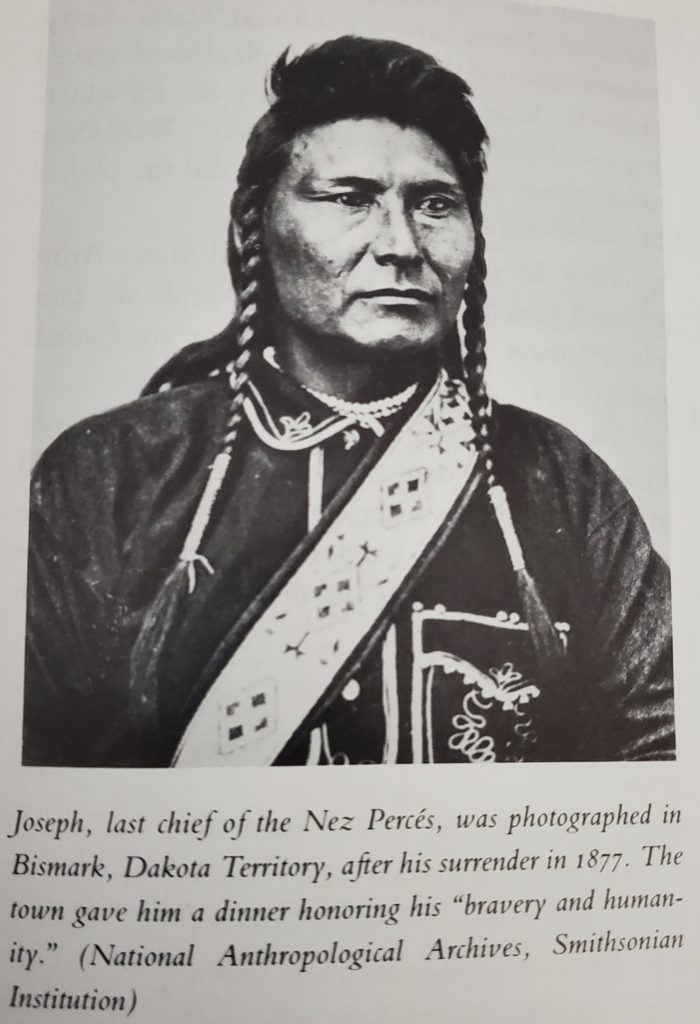In 1855, the U.S. government ordered Native Americans to cede part of their land. Five years later, gold was discovered and an influx of miners traveled to the area. In 1863, the government tried to make the reservation smaller. They wanted to reduce it to less than one-fourth of its previous size. The Native Americans were led by a chief named Lawyer. If their homes were already within the boundaries of the new reservation, he convinced them to agree to sign the treaty. The other chiefs represented about two-thirds of the tribe. They protested and withdrew from the council without signing.
One of the chiefs was an old man named Wellamotkin. He was the father of Chief Joseph and known as Old Joseph. He led a band of sixty males and many women and children. They had dwelt for years in the beautiful Wallowa Valleys in Oregon. The valley was described as having natural barriers of high mountain ranges and some of the deepest gorges on the continent. The lush alpine grasslands provided some of the best grazing ground in the region. The white settlers were anxious to take it. Because Old Joseph refused to sign the treaty, they were not able to assume ownership. For years, the Native Americans remained in the valley. White settlers began to pressure them to sign the treaty. In 1871, Old Joseph was dying so he counseled his son, who would become chief. He advised his son to always think of his country and guide the people with wisdom. He knew the white settlers had their eyes on the land. He told is son to “never sell the bones of your father and mother.”
After Old Joseph’s death, just as he said, white settlers found a route into Wallowa and moved in. They claimed the Native American’s land. His son, Young Joseph, contacted the Indian agent on the Nez Perce reservation in Idaho. After a thorough investigation, it was determined the Wallowa still legally belonged to the Native Americans. President Grant ordered the whites to withdraw. The white settlers refused and threatened to exterminate Chief Joseph’s people if they refused to leave the valley. President Grant’s orders were defied and more white people moved in. There was now friction between the whites and Native Americans. The governor of Oregon attacked Washington officials and forced the administration to reverse its position. In 1875, a new presidential order opened the Wallowa to white homesteaders. The Nez Perces were dismayed. Young Joseph recommended patience while he appealed to federal authorities.
In the meantime, the harassment of the Native Americans continued. Fearful they would retaliate with violence, a five member commission was created to meet with the Nez Perces. They met with Chief Joseph and were surprised at his eloquent logic. He refused to relinquish their tribal land. The white settlers were outraged and battled with the Native Americans to force them to a reservation in Idaho territory. They had lost trust in Chief Joseph because he recommended a peaceful surrender. He received strong support from his younger brother, Ollokot. He was a buffalo hunter with strong and courageous warrior skills. He was well respected by the younger warriors. Eventually the brothers won agreement to the surrender from the band’s council. They did not surrender quietly. Many raids and violent encounters with white settlers occurred.
Chief Joseph led his band of Nez Perce during a tumultuous time in their history The Nez Perce were forcibly removed by the U.S.federal government from their ancestral land and forced to a small reservation in Idaho. Approximately 700 men, women, and children were pursued by the U. S. Army under the leadership of General Oliver Howard. The Nez Perce fought skillfully against General Howard and his army. They thought about fleeing the United States to seek asylum in Canada, like Sitting Bull. The Nez Perce continued to skillfully fight the white attackers. Many surviving members of the band were cornered in northern Montana territory.
Weary and tired from the fighting, Chief Joseph thought it was best to surrender. Many of the women and children were starving, freezing, and sick. Many chiefs and warriors were killed. When he was unable to fight any longer, Chief Joseph surrendered to the Army with the understanding that he and his people could return to the reservation in Idaho. Chief Joseph and his warriors crossed army lines to meet with General Howard and his adjutant, Colonel Nelson Miles. When he reached them, he gave Miles his rifle. His surrender speech confirmed Chief Joseph as the symbol of the Nez Perce heroic fighting retreat. In 1885, Chief Joseph and most of his band were sent to the Colville Reservation in Washington State. He made many attempts to return to Wallowa but he wasn’t allowed to do so. He died in 1904, exiled from his beautiful tribal land.
Francie Mae. May 31, 2022.
Reference
Oates, Stephen B. Portrait Of America. Fourth Edition. Volume II. Article by Josephy Jr., Alvin M. “I Will Fight No More Forever,” 1987. Houghton Mifflin Company. Boston, Massachusetts.

A fascinating discussion is worth comment. I do believe that you should write more about this subject matter, it may not be a taboo subject but typically folks dont talk about such issues. To the next! Cheers!!
This is the perfect website for everyone who hopes to understand this topic. You realize so much its almost hard to argue with you (not that I actually would want toÖHaHa). You certainly put a new spin on a subject thats been discussed for decades. Great stuff, just great!
Can I just say what a relief to uncover an individual who really understands what theyre talking about on the web. You certainly know how to bring a problem to light and make it important. More people ought to read this and understand this side of the story. I was surprised that you arent more popular given that you most certainly have the gift.